Aval murukku | Poha murukku | poha chakli | Pottukadalai murukku | murukku recipe | pottukadalai butter murukku | easy murukku recipe | rice flour chakli | Thenkuzhal murukku recipe | Diwali bakhsanam | Diwali savory recipes | festival savory | gokulashtami quick, and tasty murukku recipes with step-by-step pictures and video recipe. Check out the poha murukku recipe and if you like the video pls SUBSCRIBE to my channel.
Aval murukku | Poha murukku | poha chakli | Pottukadalai murukku prepared with thick flattened rice, store-bought rice flour / Idiyappam flour / arisi maavu, roasted gram flour/ pottukadalai, and butter/ hot oil. Easy instant murukku recipe without any roasting and soaking
Thick or thin aval?
I have used thick flattened rice but you can also use thin or red aval
Should I roast pottukadalai?
No, you need not roast pottukadalai for the murukku.
Should i soak aval and pottukadalai?
I have washed poha hence I soaked and grinded them. if you are skipping this step, fine powder both and knead murukku dough.
Can I skip carom seed?
I have used Carom seems for extra flavor. Instead, you can use black sesame seeds, white sesame seeds, or cumin seeds according to your preference.
Can I skip butter for murukku?
Little butter gives a nice texture and taste to the murukku thenkuzhal recipe. But if you are planning to make vegan murukku skip the butter and use 1 tablespoon oil instead of butter. Personally, I like butter flavor hence I add in my all savory like seedai, thattai, ribbon. Avoid adding more butter as it will affect murukku texture. Murukku might disintegrate.
What should be the consistency of pottukadalai murukku dough?
Tight dough makes it difficult to press through the mold, it will cause murukku to break while it is pressed through the press. Also with too much water in the dough, chakli will absorb a lot of oil while frying Also murukku won't retain the shape. Make the right consistency of pliable dough
How to check if the oil is at the right temperature?
Check the oil temperature by adding a small piece of the dough. If the dough comes up gradually and steadily on top, the oil is hot enough to fry. If it comes up too quickly, then the oil is too hot. Simmer and adjust to the right temperature. If it settles down at the bottom of Kadai or comes up very slowly, the oil is not hot enough, so increase the heat.
Shelf Life for murukku
Murukku stays fresh and crispy for up to 2 weeks. Always store in a clean airtight container. I prefer to keep them in stainless dhabba. Let the murukku cool completely then close with the lid.
How to achieve the cream color murukku?
Roasted gram gives an amazing cream color to the murukku. If you are making a large quantity of murukku make the dough in batches to avoid browning. If the dough is kept for a long time murukku will turn brown. Also, avoid heating the oil too high as it might affect the murukku color and taste.
Can I add chili powder?
Traditionally butter murukku is prepared without chilli powder to retain the color and taste. However, you can add fine chilli powder/ pepper powder according to your taste.
INDIAN SAVORY BAKSHANAM
AFTER SCHOOL SNACKS IN TMF
BAKED INDIAN SNACKS IN TMF
FILTER COFFEE WITHOUT CHICORY
Krishna jayanthi recipes
AVAL RECIPES IN TMF
Ingredients:
1/2 cup flattened rice
2 tablespoon pottukadalai
3/4 cup rice flour
1 tablespoon Butter
1/4 cup + 1 tablespoon water
1/2 teaspoon Carom seeds / omam / Ajwain
Asafoetida
Required Salt
oil to fry
How to make aval murukku with step-by-step pictures
- First, wash the flattened rice
- Add pottukadalai and water; soak for 15 minutes
- Transfer to the mixie and Add butter and grind
- Furthermore, add water and fine grind
- Heat oil in a deep pan for frying murukku
- Meanwhile, prepare the dough. On a wide mixing plate add the ground mixture
- Furthermore add rice flour, salt, carom seeds, asafoetida, and required salt; mix well
- Mix well and knead. it might look sticky but if you clean your hands, dry it, and pinch, it will be pliable dough (smooth, non-sticky dough
- Cover the dough with a damp cloth or damp kitchen towel
- Furthermore, take a 3 or 5-eyed thenkuzhal plate. You can also use star-shaped ones) and fix them
- Grease the murukku maker with some oil. This prevents the dough from sticking to the mold
- Pinch a portion of the dough roll into a cylindrical shape out of dough and place the dough inside the maker
- Furthermore, place the other part on top of it
- Press murukku on parchment paper or greased ladles and leave it for a minute
- Make sure the oil is hot enough by dropping a small piece of dough, it should come up in a few seconds
- Carefully add the pressed murkku
- Avoid crowding the oil. Based on the pan width fry 2 or 3 murukku at a time
- After adding the murukku, avoid flipping them immediately with the slotted ladle as they tend to break. Let the froth vanish and at one stage oil stops bubbling, Flip over the murukku and fry on the other side
- Once the sizzling sound stops, and the bubbles reduce carefully remove using a slotted ladle and drain the excess oil out. Place it on a colander covered with an absorbent tissue paper/ kitchen towel
- For other batches of murukku, press and keep the other batch murukku on parchment paper and keep it ready. After removing the fried murukku slide the batch. Repeat the same process for the entire dough
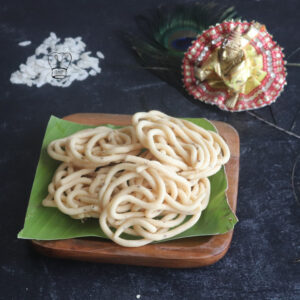
Ingredients
- 1/2 cup flattened rice
- 2 tablespoon pottukadalai
- 3/4 cup rice flour
- 1 tablespoon Butter
- 1/4 cup + 1 tablespoon water
- 1/2 teaspoon Carom seeds / omam / Ajwain
- Asafoetida
- Required Salt
- oil to fry
Instructions
- First, wash the flattened rice
- Add pottukadalai and water; soak for 15 minutes
- Transfer to the mixie
- Add butter and grind
- Furthermore, add water and fine grind
- Heat oil in a deep pan for frying murukku
- Meanwhile, prepare the dough. On a wide mixing plate add the ground mixture
- Furthermore add rice flour, salt, carom seeds, asafoetida, and required salt; mix well
- Mix well and knead. it might look sticky but if you clean your hands, dry it, and pinch, it will be pliable dough (smooth, non-sticky dough
- Cover the dough with a damp cloth or damp kitchen towel
- Furthermore, take a 3 or 5-eyed thenkuzhal plate. You can also use star-shaped ones) and fix them
- Grease the murukku maker with some oil. This prevents the dough from sticking to the mold
- Pinch a portion of the dough roll into a cylindrical shape out of dough and place the dough inside the maker
- Furthermore, place the other part on top of it
- Press murukku on parchment paper or greased ladles and leave it for a minute
- Make sure the oil is hot enough by dropping a small piece of dough, it should come up in a few seconds
- Carefully add the pressed murkku
- Avoid crowding the oil. Based on the pan width fry 2 or 3 murukku at a time
- After adding the murukku, avoid flipping them immediately with the slotted ladle as they tend to break. Let the froth vanish and at one stage oil stops bubbling, Flip over the murukku and fry on the other side
- Once the sizzling sound stops, and the bubbles reduce carefully remove using a slotted ladle and drain the excess oil out. Place it on a colander covered with an absorbent tissue paper/ kitchen towel
- For other batches of murukku, press and keep the other batch murukku on parchment paper and keep it ready. After removing the fried murukku slide the batch. Repeat the same process for the entire dough
Video
Notes
- I have used thick flattened rice but you can also use thin or red aval
- you need not roast pottukadalai for the murukku
- I have washed poha hence I soaked and grinded them. if you are skipping this step, fine powder both and knead murukku dough.
- I have used Carom seems for extra flavor. Instead, you can use black sesame seeds, white sesame seeds, or cumin seeds according to your preference
- Little butter gives a nice texture and taste to the murukku thenkuzhal recipe. But if you are planning to make vegan murukku skip the butter and use 1 tablespoon oil instead of butter. Personally, I like butter flavor hence I add in my all savory like seedai, thattai, ribbon. Avoid adding more butter as it will affect murukku texture. Murukku might disintegrate
- Tight dough makes it difficult to press through the mold, it will cause murukku to break while it is pressed through the press. Also with too much water in the dough, chakli will absorb a lot of oil while frying Also murukku won't retain the shape. Make the right consistency of pliable dough
- Check the oil temperature by adding a small piece of the dough. If the dough comes up gradually and steadily on top, the oil is hot enough to fry. If it comes up too quickly, then the oil is too hot. Simmer and adjust to the right temperature. If it settles down at the bottom of Kadai or comes up very slowly, the oil is not hot enough, so increase the heat
- Murukku stays fresh and crispy for up to 2 weeks. Always store in a clean airtight container. I prefer to keep them in stainless dhabba. Let the murukku cool completely then close with the lid
- Roasted gram gives an amazing cream color to the murukku. If you are making a large quantity of murukku make the dough in batches to avoid browning. If the dough is kept for a long time murukku will turn brown. Also, avoid heating the oil too high as it might affect the murukku color and taste
- Traditionally butter murukku is prepared without chilli powder to retain the color and taste. However, you can add fine chilli powder/ pepper powder according to your taste



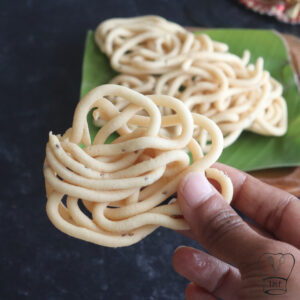
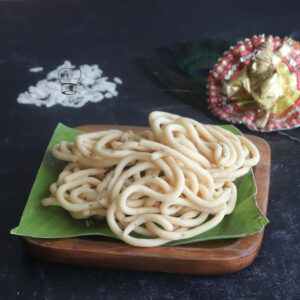
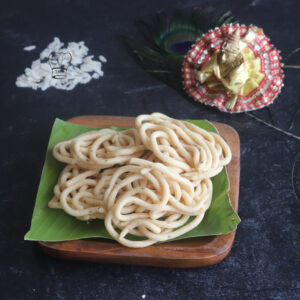


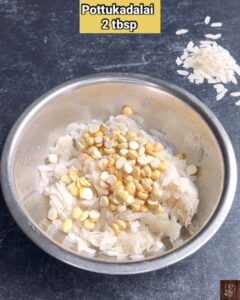


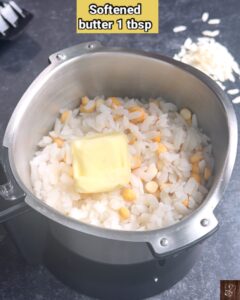
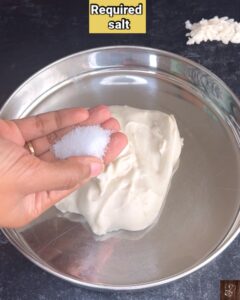




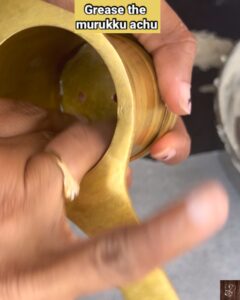




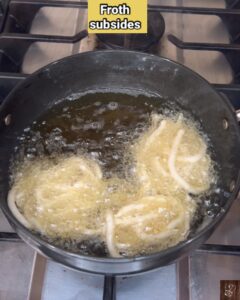
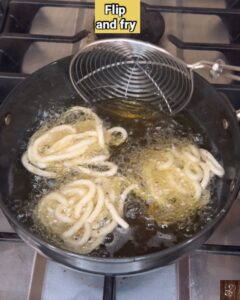


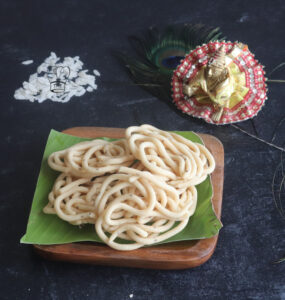
Comments
No Comments